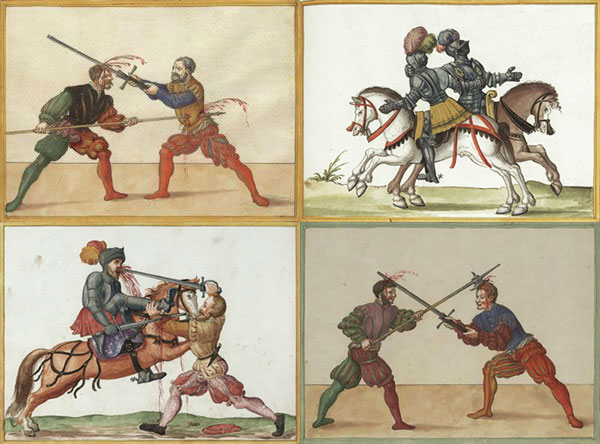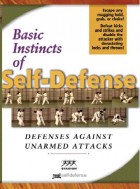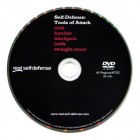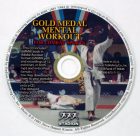What martial art, or combat sport, is best for fighting?
Do you have an answer to the eternal question: What is the best fighting art?
Many, if not most, fighting arts are attempts at creating the universally best, the winningest, fighting skills. But yet so many fighting arts exist — if one is the best, why are others still around? So, a long time ago, in the Soviet Union with its millions of athletes, some state appartchik asked top coaches of combat sports the question: “Which fighter will win in mixed matches among fighters representing various combat sports and martial arts?” (The intent of the question was to find out which fighting art produces the most effective fighters and thus is the most useful one for enforcers of the state apparatus.)
What would be your answer? Post it as a comment to this self-defense tip!
Fighting arts: For every pro there is a con
Recommended reading:
Self-Defense Tip #30 — Effectiveness of Various Combat Sports and Martial Arts
Self-defense tip from Thomas Kurz, co-author of Basic Instincts of Self-Defense and author of Science of Sports Training, Stretching Scientifically, and Flexibility Express.
Self-Defense Moves
For your defense moves to work under stress they must be based on your natural, instinctive reactions, require little strength and limited range of motion, and be proven in fighting experience.To learn how your natural reactions can instantly defeat any unarmed attack, see the video Basic Instincts of Self-Defense.
Defend Against Weapons
To defend against weapons you have to know how they are used. Also — every stick has two ends … the weapon of attack may become a weapon of defense in your hand …To learn how the typical street weapons (club, knife, razor) are used by an experienced streetfighter and how to practice with them, see the video Self-Defense: Tools of Attack — Club, Hatchet, Blackjack, Knife, Straight Razor.
Mental Toughness
Staying cool under pressure is more important for self-defense than being physically fit and technically skilled. If you can’t control your mind what can you control?To learn mental techniques that let you calmly face any threat and act rationally in the heat of a fight, click here.
For a complete list of our products, click here.









Probably the most useful is BJJ, Brazilian jiu jitsu, though boxing is good also if you end it fast.
I’m partial to:
– Roworth’s British Military Saber (Art of Defense on Foot 1798)
– Leckuchner & Liechtenauer Lange Messer & Longsword
– Kenjutsu & Musashi’s Hyoho Niten Ichi Ryu Kenjutsu
– Military Mixed Martial Art
– George Silver’s Paradoxes of Defense as a common ground between the other styles
With that anybody should be able to use nearly any object for defense 😉
Manabi-Masho Ju-Jitsu, as it’s non-competitive and solely for defense. The premise is if two men fight and one or both are not dead in 30 seconds, then it’s not a fight, it’s just a match, or you have two perfectly matched combatants trained in the same form that know all of each others counters, in which case you would probably not be fighting them to the death in the first place. At least that’s how it was taught in the ’80’s.
I’ve always observed that the fighting art doesn’t matter nearly as much as the fighter. Some judo practitioners are nearly unbeatable, some BJJ fighters are awesome and dangerous, some Karatekas can knock down walls with their fists. My answer to the question is this: be the best fighter you can be at whatever art you practice. Fighters are unbeatable (more or less), fighting arts are just starting points.
Your answer is close, in spirit if not in letter, to the answer of the top coaches. Congratulations!
There is no ‘best martial art’. I think there are lots of good disciplines, not just one in particular. A lot of this type of stuff depends on the person, their approach to the martial arts, nutrition, mental and physical conditioning and also, what the end goal is for learning the martial arts.
What I am confident saying is I think it’s pretty clear by now that traditional eastern martial arts (not Muay Thai) are pretty useless. I think I would advise someone interested in learning martial arts to start young and learn the following: BJJ, Wrestling and Gymnastics as a base, with striking added in later.
I agree. There may be some martial arts that aren’t ‘that good’ but in the end it’s the individual and the mileage he/she has put in.
It depends on what aspect of the art/skill/sport one puts the most mileage in. The clue is in the coaches’ answer I quoted: “The fighter who will be the first to successfully apply his tactics will win.”
Truth be told, if you want to defend yourself the best stuff comes from WW2 combatives. I have always said study whatever you want to for whatever reason but read ‘kill or be killed’ by Rex Appleby and you will learn what you need to know for self defense. This is the stuff that won the war for us and brought the men home safe. Nothing is unbeatable but I’ll bet my life on the tried and true. Want more? Check out Attackproof which takes the WW2 stuff and goes on from there. That is also worthwhile.
Without a doubt WRESTLING is the best and most effective fighting art. Not that a wrestler can’t lose, but if you can’t wrestle, you are going to have a hard time winning.
Thanks to all who posted their answers. All the above answers are worth reading. Only one, though, is close to the answer from the top coaches who were asked the question. Keep in mind that those were coaches of World and Olympic champions in combat sports and martial arts, of Soviet military hand-to-hand combat arts (that’s more than just Sambo), and of various fighting arts of many nations of the former Soviet Union. Also keep in mind that in the Soviet Union there was a standard system of gathering all sports training knowledge, analyzing it, testing, and then sharing with coaches of all sports. So those coaches had deep understanding of the matter and here is their answer: “The fighter who will be the first to successfully apply his tactics will win.”
Sounds a lot like the advice in Chapter 2 of Lt. Colonel Rex Applegate’s book, Kill or Get Killed: “If a general melee ensues, when both of you are on the ground striving for position and holds, the first to resort to blows, bites and gouges will come out on top. Always attack parts of your opponent’s body that are easily hurt. If the enemy can be kept in pain, he will be unable to do much offensive fighting.”
It all boils down to APPLICATION. I think this is why Peter Ralston (Cheng Hsin founder) recommended folk take boxing and judo, since they constantly do what they train to do.
For overall combat fighting, not point fighting or an “art” I truly believe in Krav Maga of which I’m a practitioner. “Combat Contact” created by the Israeli’s in the 1940’s it incorporates many different types of self defense disciplines into one combined fighting package.
I have only been in a handful of street fights and they were amateurish events at best where the other opponent was drunken oftentimes, but I did find some training in kickboxing such as keeping your guard up etc to be effective to the point where the other opponent was mimicing me. I also have worked in a patient hospital setting where a patient once grabbed me by the throat unexpectedly and whilst in that situation I would have escaped because my work mates were there, I later did attend a class on Krav Maga where using the ‘escape technique’ that was taught would not have worked in my situation as my back was to a wall where the technique shown was not going to be effective.
As for what the best martial art is, there probably is no singular best art. A variety of disciplines is required to have some kind of proficiency. I do think that mixing in some combat only art such as Krav can only be effective when mixing it up with other disciplines such as wrestling and boxing/Muay Thai. I like looking at fighters smaller in height because they HAVE to be technique based and effective. I do feel the need to point out that BJJ is mostly used in a cage fighting setting and if you use BJJ and get an opponent on the ground, what is to stop his five friends from then kicking you on the ground etc and stabbing you? I think you have to strike first, strike hard, and use some form of body manipulation/standing joint locks to get the opponent to the ground, then use strikes whilst they are on the ground. You cant afford to get into a prolonged wrestling scenario as in the situations I have seen that guy usually has buddies around who will kick you in once you are on the ground, wrestling in a protracted scenario only works if you are 1 vs 1 and even in a cage…this is why I dont like people saying BJJ is the end-all martial art, or even that MMA is the best as this is only applied in a cage setting. Sure, learning MMA gives you a huge advantage, but it is a sport not for everyday fighting where people sometimes are wearing thick clothing that nullifies the effect of your punches etc. I have even heard of a tale where a MMA fighter caused an assailant to ‘tap out’ and when the guy started fighting the MMA fighter let him go and was subsequently stabbed and killed by the assailant. His MMA conditioning caused him to let go of the assailant when he tapped, and that was the cause of the MMA fighter’s demise.
Someone here mentioned ‘eastern martial arts’ are debunked…I dont think this is true, there was a 5′ 6 135 lbs guy who submitted a 6′ 6 behemoth with his eastern martial arts, and only lost later on in the tournament in the final against another opponent due to the eye injuries suffered from the 6′ 6 guy who used illegal eye gouges, the name of the short guy was Yuki Nakai.
I think a striking discipline + wrestling discipline + standing joint lock discipline + Krav Maga/other combat only art involving weapons training = the overall package. So there is no ‘best’ martial art. I don’t like the idea of belts in the sense that people with higher ranked belts are often overcome by lower ranked ones, there is no consistency here. I dont like MMA as a recreation of real life combat, nor do I like ‘combat only’ arts like Krav being used in isolation without learning other martial arts disciplines. And even all that practice is pointless if you dont address legal ramifications after the fight, and know that even after all that training all may be lost if the other guy’s buddies step in/ he produces a gun at range/ etc etc… heck, the worst predators aren’t the guys who fight fairly, they’re the guys who stab you in the back or as in days past, poisoned you. I think a total combat discipline that encompasses multiple martial arts also needs to address the psychology of opponents who win by fighting dirty and in an asymmetrical fashion. Sorry I talked too much, I was just sharing my opinion which even though I may not be necessarily ‘right’ in all I said, I did feel I have some genuinely good points to contribute to the discussion.
I didn’t read the above comments yet, but, in my opinion, 2 statement are reasonable answers to the question, “what’s the best fighting art”: 1) There is no a better martial art method, but a better martial art fighter; 2) ” you fight the way you train” (Musashi); After 40 years digging in the martial arts world as a supporter, searcher, practitioner of some of most known fighting ways, I confirm it by my experience.
I think the point of the question is what martial art is the best for me. I am not so interested in who’s gonna win the world championship of all fighters and most of all, I can’t train 8 hrs every day.
In my experience, Systema is perfect. I tried Guided Chaos only once, but I felt its concreteness. BJJ is wonderful, if nobody has a knife.
My respect to all martial arts and artist.